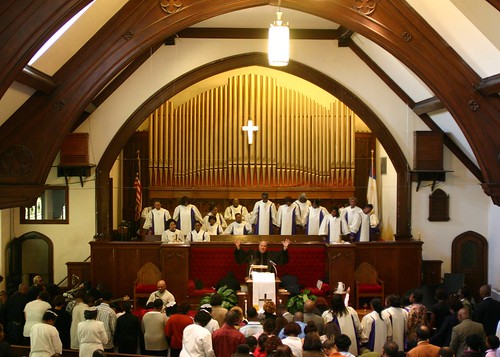Although gospel music, by which we mean traditional church music, can be traced back over 2,000 years, the Afro-American inspired gospel music that we recognise today can find its roots in the 17th century.

Origins of Gospel
Gospel music was originally founded to promote group participation during times of worship. As it involved oral interaction, it was seen as ideal for including everyone within a community when many people were illiterate, thus avoiding social exclusion and marginalisation of individuals.
On a more sinister level, gospel was also used as a means of conducting slavery indoctrinations; slaves could not read or write, and there was no desire or need among slave masters to teach them.
Gospel Song
It was not until the late 19th century that gospel music started to stand out as its own genre, being used for performance and enjoyment rather than exclusively for religious and ‘business’ purposes. In 1874, the American composer Philip Bliss released Gospel Songs: A Choice Collection of Hymns and Tunes.
The songs written by bliss were notable for being easier to sing than traditional church hymns, while popular singers would be used to perform the songs and inspire people to explore this alternative to the choral church music they would have been used to singing themselves.
Because this gospel revival movement was so popular, and spread through communities as well as churches in the late 19th and early 20th centuries, a number of publishing houses were quickly set up specifically to produce and spread gospel music.
Early 20th Century Gospel
The popularisation of gospel music reached out to a new audience, particularly among those communities where church going was not seen as an essential and religion was not a major part of life. This was primarily led by church congregations beginning to bring their own instruments along to church to create a fuller music experience, where the gospel music would be sung against the backdrop of instrumental sound.
The invention and development of the wireless radio from 1919 onwards meant that gospel music was heard around the world. Recordings of gospel would start to become commercially successful, with groups like The Carter Family and The Fairfield Four enjoying fame and success. At the same time, the differences between black gospel and white gospel, and the conflict these differences often created, were never far from the surface.
Post War Gospel
It was not until the conclusion of the Second World War that live gospel performance would become popular worldwide. In 1959, the famous Madison Square Garden became the home for the Negro Gospel and Religious Music Festival.
Even today, black gospel and white gospel are considered two different genres, with separate audiences and artists. Despite this split, there are no racial motivations driving the continuation of the split today, although there are no signs of both genres coming together as one.
Image Author: Chris Larkee
Are you a guitarist? Check out our full range of online guitar lessonsAre you a saxophonist? Check out our full range of online saxophone lessons
Subscribe to Pro Music Tutor from as little as £7.99 per month
Related Posts
-
Is Music Theory Important to Modern Musicians?
The importance of music theory is a hot debate topic in the world of professional music. Some believe knowledge of music theory is what makes you a true musician, whereas some feel their lack of music theory knowledge is like a badge of honour. With the eternal debate over the importance of music theory raging […]
View All >> -
5 Ways Spanish Music Influenced the World
Contemporary popular music has transcended all national boundaries, with different types of music being performed and listened to in all corners of the world. Each culture also adds their own little tweaks and twists to the music, constantly creating new sounds and influences. Spanish music has deeply influenced the popular music we listen to today. […]
View All >>
Latest Blog Entries
-
The Benefits of Online Music Education
Learning music has never been easier, since the internet and modern technological advancements have opened the doors to countless possibilities, expanding the subjects people can choose from and how the lessons are taught. Now, people can study a whole host of music-related topics; from learning to play guitar or DJing, to understanding the inner workings […]
View All >> -
Essential Jazz Guitar Scales that are Easy to Learn
Improvising in jazz requires the ability to play in different keys over different chords. Results certainly do not come overnight, but with diligent practice, you would be surprised by what you can achieve. Many people ask me about what scales I use as if they were some big secret. While knowing your scales is very […]
View All >>
Blog Categories
- Categories
- Guitar Tips (93)
- History (36)
- How-To (38)
- Interviews (3)
- Music Industry (121)
- Prolinks Guitar (2)
- Prolinks Lessons (3)
- Prolinks Tutor's Profile (1)
- Saxophone Tips (40)
- Uncategorized (6)
Tags
Archive
- November 2018 (1)
- February 2018 (1)
- December 2017 (1)
- November 2017 (1)
- October 2017 (1)
- July 2017 (4)
- May 2017 (2)
- April 2017 (1)
- August 2016 (2)
- July 2016 (1)
- June 2016 (2)
- May 2016 (3)

